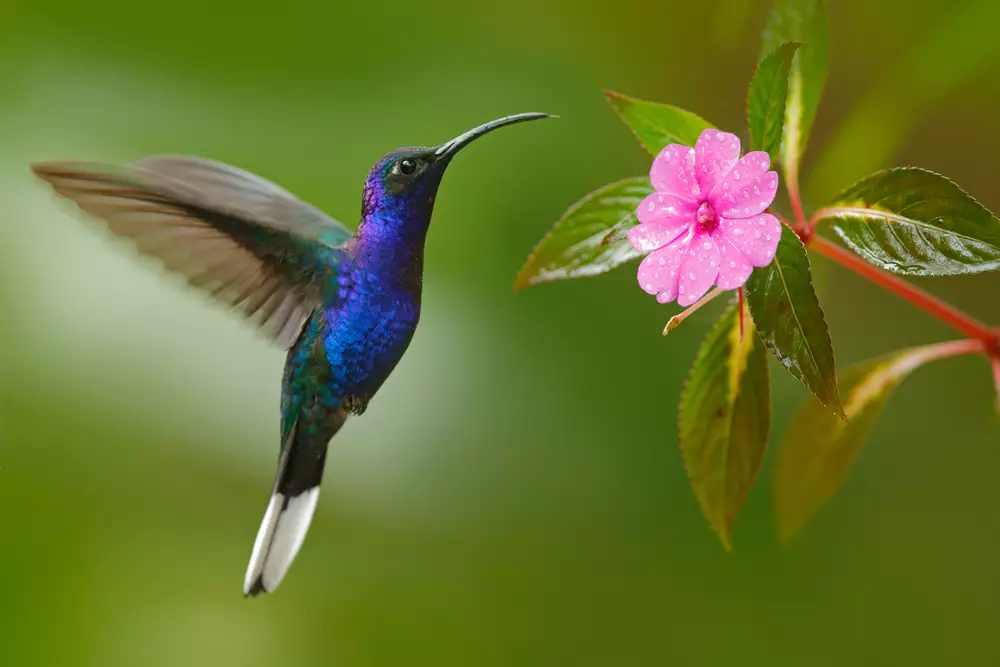Hummingbirds, nature’s tiny aviators, are the subject of much fascination and study. Their fluttering wings, speed, and vibrant colors captivate the minds of ornithologists and casual observers alike. With over 330 species distributed across the Americas, these little birds have an intriguing variety of traits and behaviors.
To classify them as carnivores, herbivores, or omnivores is no simple task. Their diet primarily comprises nectar and small arthropods. Therefore, hummingbirds hold an omnivorous status, as they consume both plant-derived nectar and small animals such as insects and spiders.
However, a simple label might not do justice to the complexity of their feeding habits. The intricacies of the hummingbird diet encompass an interesting mixture of herbivorous and carnivorous characteristics that push the boundaries of the traditional dietary classifications.
A Look at Hummingbird Diets
The Predominance of Nectar
The sweet nectar of flowers serves as a primary component in the hummingbird’s diet. The intimate relationship between these birds and flowers is a stunning illustration of the intricate web of nature. The bird’s unique beak shape and the hovering ability have evolved in large part due to this symbiotic relationship.
Role of Nectar in Hummingbird Energy
High in sugar, nectar acts as a rapid energy source for these fast-flying birds. The incredibly high metabolism of hummingbirds – with heart rates reaching as high as 1,200 beats per minute – necessitates a diet rich in quickly metabolizable energy. Nectar, composed mainly of simple sugars, fits this requirement perfectly.
Adaptations for Nectar Feeding
Hummingbirds have developed specialized physical traits to optimize their nectar consumption. Their long, slender beaks and equally long tongues allow them to reach deep into flowers and extract nectar. Remarkably, hummingbirds also have a unique mechanism that enables their tongues to trap nectar, helping them consume it more efficiently.
Insects and Spiders in Hummingbird Diets
Contrary to popular belief, nectar isn’t the sole sustenance for hummingbirds. Insects and spiders play a pivotal role, especially for their protein needs.
Why Insects and Spiders Matter
While nectar provides energy, it falls short on other nutritional necessities like proteins, fats, and various minerals and vitamins. Insects and spiders fulfill these needs. They constitute a critical part of the hummingbird diet, particularly during the breeding season and the growth period of nestlings.
How Hummingbirds Hunt
Hummingbirds demonstrate diverse hunting strategies. They can catch insects mid-flight or pluck them from leaves and bark. Even spider webs are on the menu, as they often hold trapped insects and offer the added bonus of spider eggs.

Dietary Classification of Hummingbirds
Classifying hummingbird diets isn’t straightforward due to the mix of plant and animal components. However, exploring their herbivorous, carnivorous, and omnivorous traits gives us a deeper understanding.
Are Hummingbirds Herbivores?
Evaluating the Herbivorous Argument
The consumption of plant nectar might suggest hummingbirds are herbivores. Their mutualistic relationship with flowering plants and specialized nectar-feeding adaptations further strengthens this argument.
Limitations of the Herbivore Theory
However, the herbivore classification becomes insufficient when considering their insect and spider consumption. Herbivores exclusively consume plant matter, so the insectivorous side of the hummingbird’s diet contradicts this categorization.
Are Hummingbirds Carnivores?
Assessing the Carnivorous Angle
If we focus on the hummingbirds’ insect consumption, one might argue they are tiny carnivores. This perspective is particularly appealing when considering nestlings’ diets, which are heavily animal-based to support their rapid growth.
Limitations of the Carnivore Theory
Yet again, the classification falls short. Carnivores primarily eat animal matter. As hummingbirds consume a significant amount of their diet in the form of plant nectar, the carnivorous label doesn’t completely fit.
Are Hummingbirds Omnivores?
Evaluating the Omnivorous Standpoint
Given the mixed diet of plant nectar and animal matter, hummingbirds fit most accurately into the omnivore category. Omnivores consume both plant and animal food sources, and hummingbirds’ nectar and insect consumption fulfills this criterion.
Validating the Omnivore Classification
Despite the limitations of categorizing diets, the omnivore classification aligns best with our understanding of hummingbird feeding habits. They rely heavily on the energy from nectar while requiring insects and spiders for other essential nutrients.
Implications of the Hummingbird Diet
Hummingbird Adaptations to Diet
The dietary needs of hummingbirds have resulted in fascinating physiological and behavioral adaptations. They have developed a unique wing movement pattern to hover in place while feeding, an extremely rapid metabolism to process the energy-rich nectar, and sharp eyesight and agility to catch small insects.
Role of Diet in Hummingbird Behavior
The omnivorous diet of hummingbirds has shaped many of their behaviors. For instance, their migration patterns often follow the flowering of their preferred plants. They also show territorial behavior around abundant food sources.
Frequently Asked Questions
What percentage of a hummingbird’s diet is nectar?
Hummingbirds derive about 90% of their energy needs from nectar. However, this is supplemented by small arthropods, particularly for protein.
Can hummingbirds live on nectar alone?
No, while nectar provides quick energy, hummingbirds also need protein, vitamins, and minerals which they obtain from insects and spiders.
Do all species of hummingbirds have the same diet?
While there are variations across species, most hummingbirds have a diet comprising both nectar and small arthropods.
Closing Thoughts on Hummingbird Diets
The diet of hummingbirds offers a compelling look into the diverse eating habits in the animal kingdom. While they primarily feed on nectar, insects and spiders form a vital part of their diet. This mixture of food sources makes hummingbirds fascinating creatures to study, breaking traditional dietary classifications.
Unraveling the hummingbird diet also emphasizes the complex interplay of energy and nutrient needs in animals. Each species has adapted to its environment and available resources in unique ways, and hummingbirds are no exception.
By better understanding the feeding habits of these avian marvels, we gain further insight into nature’s incredible biodiversity. Such knowledge highlights the importance of protecting diverse habitats that sustain varied diets and contributes to a richer appreciation of the natural world.
